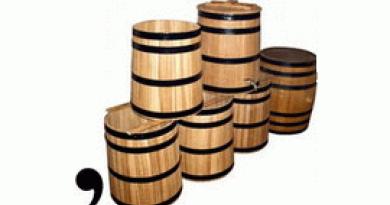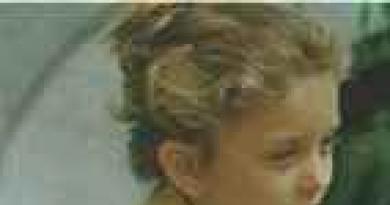The cross-shaped set of loops (Bulgarian beginning) has long been used in knitting to finish the edge of the product. It creates an elastic thickened edge.
To make this set of loops, fold the thread coming from the ball in three, and the length of the triple thread should be approximately three times greater than the width of the part. We place the thread on the fingers of the left hand, the triple thread from the ball hangs from the thumb, and the thread coming from the ball hangs from the index finger. We insert the knitting needles folded together into the loop, as shown in the photo.

We press the threads with the index finger of the right hand to the knitting needles and form the first loop, grabbing the triple thread from the outside of the thumb of the left hand.


We form the second loop by grabbing the triple thread with inside left thumb. To do this, the position of the triple loop on the thumb of the left hand needs to be changed: throw off the thread and immediately pick it up from the opposite side of the finger.

By picking up loops alternately from the outside and inside of the left thumb (which is why the method is called cross-shaped), we get a series of loops that are placed on the knitting needles in pairs.
This is what a cross-shaped typesetting row looks like from the front side.

Then every loop pairs are knitted knit or purl depending on the pattern with which the product will be made.
Based on the cross-shaped set, you can make an openwork set row.
Openwork typesetting based on the Bulgarian beginning

To obtain an openwork edge, we cast on the initial row in a cross-shaped manner. Turn the knitting over to the wrong side and knit an openwork row, yarn over before each pair of loops, and knit the pairs of loops together with a purl loop. After the initial row we knit several rows facial loops(garter stitch) and then move on to knitting the main stitch. This method of setting the initial row is especially good for finishing women's and children's products.
The cross-shaped cast-on stitches are made using double thread, with the length of the thread being equal to twice the length of the cast-on edge.
Step 1
According to the drawing, place a single thread coming from the ball over the index finger of the left hand and bring it to the thumb. Fold the thread in half and make a loop around the thumb, with the end of the thread hanging down at the thumb.Step 2
Make the first loop in the usual way: insert the knitting needles into the loop on the thumb, grab the thread coming from the index finger and pull it out of the loop. Slip the loop off your thumb and tighten the loop on the knitting needles.Wrap the double thread around the thumb of your left hand according to the picture, holding the starting thread with your right hand. A single thread coming from the ball is draped over the index finger and leads to the knitting needle. Pull out the loop (see direction of the arrow), slip it off the thumb and tighten it on the knitting needle.

Step 3
Place the double thread around your thumb and pull the loop in the direction of the arrow. Slip the loop off your thumb and tighten it on the knitting needle. Alternately perform loops according to step 2 and step 3.
Step 4
This is what a series of loops cast on in a cross pattern looks like.
Drawings: Verena magazine
Cross casting is considered one of the most ancient methods of casting on loops. As a rule, it is used in cases where the edge of the product is made without an elastic band, that is, immediately with the main pattern, suitable for 2x2 elastic bands. With a cross-shaped cast-on, the edge turns out to be especially smooth and neat, and the volumetric interweaving of the threads makes the cast-on edge a decorative element. If the edge should hold its shape well, a cross-shaped set of loops with double thread is recommended. Always after a cross cast on, one row is knitted with purl loops and this is the purl (zero, initial) row of work!
A cross-shaped set of loops is made using one or, depending on the thickness of the yarn, two knitting needles. The main and additional threads for casting on loops should be the same length.
How to make a cross-shaped set of loops - step-by-step photo master class.
Cross casting is considered one of the most ancient methods of casting on loops. As a rule, it is used in cases where the edge of the product is made without elastic, that is, immediately with the main pattern.
With a cross-shaped cast-on, the edge turns out to be especially smooth and neat, and the volumetric interweaving of the threads makes the cast-on edge a decorative element.
Before you start casting on stitches in a cross pattern, fold the thread in half. First, loop the thread around your thumb and then along the outside of your thumb and index finger. For ease of casting, press the free ends of the thread with your little finger and ring finger.
Using knitting needles towards the inside of your thumb, pick up the thread coming from your index finger.
Then pull the thread into a loop as in a normal cast-on.


After this, use your knitting needles to pick up the thread coming from your index finger.

Remove your finger and tighten the loop.


After this, turn the thread around your thumb, that is, lay it so that the free end of the thread this time is the front wall of the loop formed.

Then use your knitting needles to pick up the thread coming from your index finger and bring it under the front wall of the loop at the base of your thumb.

Pull the thread into a loop.

Take your thumb out and tighten the loop.

When performing a cross cast, alternate steps 5–9. It is important to remember that when casting on loops in this way, the free end of the thread in two folds must first pass behind thumb, and then in front of him. By alternating this way of turning the thread back and forth, you will get a smooth edge of the fabric due to the cross-shaped set of loops.

When picking up loops in a cross pattern, you don’t have to knit the edge of the fabric with an elastic band or use other methods for processing it.

Or so
Unwind the end from the ball twice as long as required for the initial row. Fold this end in half and place it on the index finger of your left hand with the end coming from the ball. Form a loop on your thumb using the double thread.

To make the first and all odd stitches, insert the needles into the stitch on the thumb, grab the thread coming from the index finger, bring it out of the loop, slip the loop from the thumb and tighten the loop on the needle with a double thread. Cast on the next loops with one thread, and form their lower edge from a double thread. For the second and all even-numbered stitches, place the yarn over your thumb, pass the needles under the outside of that yarn, grab the yarn coming from your index finger, and bring it out of the loop.

Slip the loop off your thumb and tighten the loop on the needle with a double thread.
A set of loops of the initial row with a thickened bottom chain
The thickened edge is used when knitting mohair products. When working with mohair thread, the density of loops (that is, the number of loops in 1 cm) of the initial row is greater than the loops of the fabric. As a result, the edge becomes tight. This defect is very noticeable in the product. In addition, such an edge breaks very quickly. The thickened edge is also used to strengthen the bottom edge when knitting socks, mittens, details such as sleeves and patch pockets, etc.
As a result of this type of stitch casting, the bottom chain becomes thicker. The starting position of the thread for casting is shown in the figure.
A cross-shaped set of loops with double thread makes the edge of the product very elastic and at the same time holds its shape well. In this case, the edge does not tighten the canvas and a beautiful, even edge with a voluminous edge is formed. The cross-shaped set of loops with double thread is also known as the Bulgarian beginning. This edge looks very impressive and neat on the product. It turns out especially advantageously on a canvas made with stockinette stitch. It is often used for casting on loops in women's and children's garments, when the main pattern begins immediately from the edge. It will also look good on 1x1 and 2x2 elastic bands; in these cases, the product has an original edge.
1. Fold the thread twice as long as the width of the fabric being collected.
2. We place the working thread in the left hand in such a way that the double thread rests on the thumb, and we wind the single thread coming from the ball (in the direction of the arrow) around the index finger and around the little finger as shown in the figure.

3. We put two knitting needles together and cast on the first loop from one thread. We place the knitting needles under the formed loop on the thumb and grab the working thread coming from the index finger in the direction of the arrow. Then we lower the loop from the thumb, and tighten the initial loop.

4. To form the next loop, change the position of the thickened thread on the thumb. We place a double thread around the thumb of the left hand. Then we grab the working thread from the index finger and pull it in the direction of the arrow through the threads on the outside of the thumb. Pull your thumb out of the loop and tighten the loop.

5. The threads are positioned in the same way as in point 4. When knitting a loop, we grab the working thread from the index finger and pull it in the direction of the arrow through the threads on the inside of the thumb. Pull your thumb out of the loop and tighten the loop.

6. Cast on all other loops as in steps 4 and 5 the required number of times. The loops are alternately cast on from the outside and then from the inside of the thumb. With this set, the loops are arranged in pairs. The exception is the edge loop.

7. After you have cast on the required number of stitches, release one needle and purl the first row using a single thread. Knit double loops each separately.
You might be interested to see:
 |



